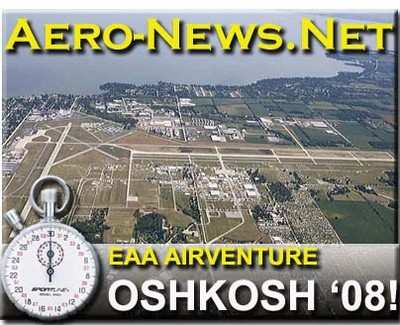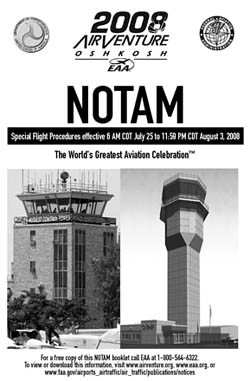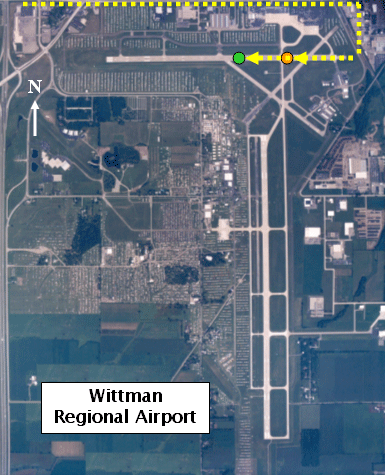Agency Works Year-Round To Make Event Safe
by ANN Correspondent Dave Slosson
Do you think that only the pilots and EAA personnel plan for
next year’s AirVenture way in advance? Well, think again. The
FAA keeps the safety of the operation front and center during
AirVenture and starts considering changes for 2009 immediately
after this year’s event ends.

 Every day of AirVenture, at 6 am, EAA flight line operations
crews and the FAA controller crews have a pre-shift briefing at the
control tower. They discuss the anticipated weather trends,
focusing heavily on the winds, choose what traffic flow to run,
discuss taxi routes, and any airport issues that need to be
considered such as scheduled mass arrivals. The evening crews
repeat this process at 1 pm.
Every day of AirVenture, at 6 am, EAA flight line operations
crews and the FAA controller crews have a pre-shift briefing at the
control tower. They discuss the anticipated weather trends,
focusing heavily on the winds, choose what traffic flow to run,
discuss taxi routes, and any airport issues that need to be
considered such as scheduled mass arrivals. The evening crews
repeat this process at 1 pm.
At 2 pm, the morning crews reassemble to discuss problems
encountered such as bottlenecks in traffic flow or areas that
caused confusion and offer suggestions to alleviate the problems.
These suggestions are then relayed to the evening crews to fix the
problems on the fly. The evening crews will also meet after the
field closes and repeat the debriefing process. Any problems and
solutions mentioned in these briefings are discussed in the next
year’s planning sessions.
The day after AirVenture is over, members of the FAA management
team and the EAA flight line operations staff meet to discuss what
went right, what went wrong, and discuss lessons learned to help
focus on any problems or issues to address for next year. Was a
runway change too slow or not communicated in a timely manner? Was
traffic flow properly restricted during an airport emergency? Was
Fisk properly controlled for smooth operations at the airport?
One month later, in September, the same groups meet separately
then corporately to brainstorm any procedural or operational
changes that should be made to correct the problems and issues.
Additional input that is weighed in these discussions includes
items mentioned in post-event controller critiques, pilot feedback
from the online surveys, and EAA feedback from any other
sources.
Last year, roughly 800 pilots filled out the online surveys
after the event. This input helps see the pilot side of the
operation. The groups continue to discuss potential changes via
monthly telephone conferences until consensus is reached.
Procedural changes need to be finalized by early February so the
NOTAM can be in the publisher’s hands in early April. The
NOTAM goes online and is published for printing simultaneously. Any
operational changes need to be finalized by late April to make the
deadline for training packages for controllers, which are sent out
in May.
What changes have we seen over the recent years that these
groups have recommended? The colored dots on the runways, roughly
every 1500’, helps both pilots and controllers communicate
plainly and simply where to land for proper separation from those
around them. Color flows were in use but a year or two before being
abandoned as too tough to remember what color corresponded to what
flow pattern.

The desire to give pilots advance information on the status of
Oshkosh airport yielded a toll-free phone number connected to the
arrival ATIS. Adding a taller antenna at Fisk this year will also
help the VFR arrivals know well before Ripon whether they need to
hold or not. The left downwind operation for Runway 18R was added
for more options in running the arrival flow with southerly winds.
Using a separate frequency and a couple controllers to operate
Runway 18L was added to reduce departure delays post-airshow. The
cards in the aircraft windows help communicate where the pilots
wish to go without the ground directors having to approach an
operating aircraft.

Planning ahead for your arrival at the world’s best
airshow? You’re not alone, as the FAA air traffic team has
been planning since last year’s show ended, and really even
during the previous show. They’re ready for you; are you
ready for Oshkosh AirVenture? Have you thoroughly digested this
year’s NOTAM? Your safety and that of those around you depend
on you following the proper procedures to the letter. Be safe, have
fun, and we’ll see you at the show!
Our thanks to Susan Parson, Flight Standards Division, and
Wanda Adelman, Milwaukee tower manager and Oshkosh tower manager
during AirVenture, for contributing to this article.
 ANN's Daily Aero-Linx (05.02.24)
ANN's Daily Aero-Linx (05.02.24) ANN's Daily Aero-Term (05.02.24): Touchdown Zone Lighting
ANN's Daily Aero-Term (05.02.24): Touchdown Zone Lighting Aero-News: Quote of the Day (05.02.24)
Aero-News: Quote of the Day (05.02.24) ANN FAQ: Contributing To Aero-TV
ANN FAQ: Contributing To Aero-TV NTSB Final Report: Cirrus Design Corp SR20
NTSB Final Report: Cirrus Design Corp SR20






